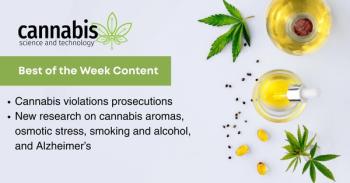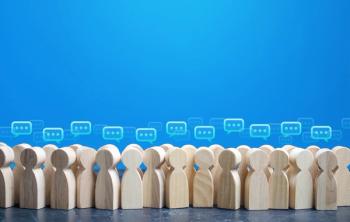
Cannabis Science and Technology
- June 2021
- Volume 4
- Issue 5
Intellectual Property and Cannabis: A Look at the Current Landscape and Emerging Topics

Sheila Gibson, the founder of Aura IP Law, shares her insights, knowledge, and advice on cannabis IP, including emerging topics.
In this installment of “Cannabis Crossroads” I interview Sheila Gibson, the founder of Aura IP Law. She started her career in intellectual property (IP) at a nationally recognized IP boutique and practiced at several top-tier law firms during her first 16 years as an attorney. She worked in the biotech industry prior to attending law school and pursuing a career in IP. She brings a unique combination of strong science and IP experience with a solid understanding of her clients’ business needs. Sheila is able to use her unique skill set and approach to provide more efficient and tailored legal services for her clients. Here, she shares her insights, knowledge, and advice on cannabis IP, including emerging topics.
Can you give a brief overview of how IP and patent law is applicable to the cannabis industry?
In every industry, cannabis included, a company’s most valuable assets are its unique strengths that provide a competitive edge over others in the same space. These strengths can include, for example, a new discovery, a new product, a secret formulation, a new product design, a new plant variety, a new method of making a product, a new method of treatment, manufacturing know how, a brand that consumers reach for, a great slogan, distinct packaging, a loyal following, client lists, or supplier lists. Whatever the strengths may be, every cannabis entrepreneur, innovator, and company should specifically identify them and have a plan in place for protecting each of these valuable assets. This is what intellectual property (IP) is all about—protecting the intangible assets that provide a competitive edge. Even though IP is protected at the federal level and most cannabis remains federally illegal, it is absolutely possible to obtain meaningful IP protection for all facets of the cannabis industry.
Could you share with our readers what led you to get involved and apply your skills to the cannabis industry?
Prior to focusing on cannabis IP, some of my biggest clients were in the cancer immunotherapy space. I was working with world-renowned cancer researchers to obtain global patent protection for their cancer immunotherapeutics. Working in patent law can be a grind. It’s very intense and deadline heavy and it’s quite easy to lose sight of your why. To stay connected to the bigger picture of the work I was doing, I would follow cancer patient journeys online to keep the patients and my contribution to improving their lives at the forefront.
Around 2015 I started following a pediatric patient account on Instagram, @prayersforsophie. Her parents, Josh and Tracy Ryan, were treating their infant daughter’s optic pathway glioma with cannabis. I followed Sophie’s journey in real time and was immediately captivated by her spirit, her energy, and her journey with cancer and cannabis. This ignited in me a desire to learn more about cannabis as medicine, which in turn fueled my desire to help facilitate patient access to cannabis.
With my practice being a federal practice and cannabis being federally illegal, it was not immediately clear to me how my skill set could be useful to the cannabis industry. However, as I continued to think through the issues, it became apparent that the industry not only needed IP protection but that meaningful protection could indeed be obtained with the right amount of determination, mental gymnastics, and legal maneuvering. While patent protection for cannabis innovation is fairly straightforward, including plant patent protection for cannabis cultivars (or strains), federal trademark protection requires “use in commerce,” which is commerce that is regulated by Congress. Given the federal illegality of cannabis, we are not always able to demonstrate “lawful” use in commerce for all goods and services offered even where those goods and services are being lawfully offered in a particular state.
IP serves to both foster innovation and protect consumers from confusion among brands. Fostering cannabis science research and having reliable and trusted cannabis brands will ultimately help create better patient access. This is what drives me to really listen and understand the unique issues the cannabis industry faces with respect to IP and to think through them creatively and through the lens of my extensive experience helping other industries protect their IP. Figuring out how to obtain meaningful IP protection before a federal agency for a federally illegal plant has sparked a passion in me unlike any other in my career.
What type of clients and projects do you currently work with in the cannabis space?
I currently work with innovators and startups in the cannabis space on their patent and trademark matters. On the patent side, I’ve worked with both ancillary and plant-touching companies on matters ranging from simple mechanical inventions to complex product and nutrient formulations. On the trademark side, I’ve developed comprehensive trademark strategies to obtain meaningful trademark protection of brands for cannabis operators, researchers, product developers, and innovators.
Can you talk a little about your science degree and how you utilize it in your work?
My science degree is in microbiology and molecular genetics and I had a brief stint in the biotech industry in a good manufacturing practice (GMP) manufacturing facility for a gene therapeutic for hemophilia patients. My technical background allows me to speak the same language as the innovators I represent and to get up to speed quickly on their new technologies so that I can develop an IP strategy specific to their ideas and business goals.
Having a science degree (or equivalent course work) is a requirement to become a patent practitioner. The United States Patent and Trademark Office (USPTO) requires all patent practitioners to demonstrate “the necessary qualifications to render to applicants or other persons valuable service, advice, and assistance in the presentation or prosecution of their applications or other business before the [USPTO]” (1,2).
The necessary qualifications include both scientific and technical training and knowledge of applicable patent laws, rules, and procedures. Scientific and technical training is demonstrated through possession of a bachelor’s degree in science or engineering from an accredited university (or equivalent) and knowledge of patent rules and procedures is demonstrated by passing a rigorous examination, the “patent bar.” While you have to demonstrate scientific and technical training in order to sit for the patent bar, you do not need to be an attorney. Patent agents are non-attorney patent practitioners who possess the requisite scientific and technical training and have passed the patent bar.
What emerging topics or new areas of interest are you seeing in the cannabis IP and patent law space? Is there anything our readers should be aware of?
The question I’m probably asked most frequently is whether it’s actually possible to patent a cannabis plant and the answer is yes, asexually reproduced cannabis plants. A patented plant must differ from known plants by at least one distinguishing characteristic that is more than that caused by different growing conditions or fertility. There is nothing in US patent law that excludes cannabis plants from being patented. While a plant patent protects against asexual reproduction of genetically identical clones, it does not prevent a patented plant from being used for breeding. Thus, plant patents are most useful in combination with strong IP licensing agreements to control the activities of those you trust your plants to. A search of USPTO patent records revealed at least 25 issued plant patents and almost 50 pending plant patent applications that include the term “cannabis.”
Utility patent protection is also available for cannabis innovation. In fact, the United States government holds a now-expired patent for a method of treatment that dates back to 1998. So far this year, I am seeing an uptick in cannabis patent filings generally.
The most common cannabis IP myth I encounter is that trademark protection is not available for cannabis due to the “use in commerce” requirement. While it is still not possible to obtain federal trademark protection for certain plant-touching goods and services, a lot has opened up in terms of being able to obtain meaningful trademark protection at the federal level even for plant-touching businesses. Where initial cannabis trademark strategies involved obtaining protection for apparel, we are able to obtain protection for services such as providing information, including information about consuming, growing, processing, and infusing with cannabis, or about cannabis products. It is also possible to obtain state trademark protection for plant touching goods and services in many states where cannabis is legal. If your cannabis trademark strategy started and ended with apparel, it’s time to revisit your trademark portfolio.
As for trends in cannabis IP litigation, we are seeing a lot of litigation brewing around trademarks. Initially, the litigation primarily involved established and famous brands suing cannabis parody brands (such as Gorilla Glue, UPS, Tapatio, and most recently, Skittles). We are now seeing cannabis brands sue each other over similar marks and partners within the same entity sue each other over rights to their existing trademarks.
While there is still an outstanding question about the enforceability of cannabis patents in federal courts, thus far, courts have moved forward with lawsuits involving cannabis patents without throwing them out based on ineligible subject matter. Even if cannabis patents were to be deemed unenforceable due to the current federal status of cannabis, patents are enforceable for 20 years from their earliest filing date. Provided the federal status changes within the 20-year term, there is still a lot of value to be had from early cannabis patents.
Do you have any advice for anyone interested in a career in cannabis IP or patent law?
One of the most exciting things about a career in patent law is the ability to work on a wide variety of technologies even within a single sector, such as cannabis. You must be able to get up to speed very quickly on a new invention and be able to describe the invention in words and drawings in a way that meets all of the patent requirements. On any given day, you may be working on several completely different technologies and you must be able to switch between them easily. In my experience, most scientists who become patent practitioners are those who love science, but did not enjoy being in a laboratory setting or being devoted to a single subfield of science.
Patent law can be very demanding, requiring you to juggle multiple inventions of differing technologies, each with its own unique set of issues and non-extendable deadlines. Missing patent deadlines can have dire consequences, so organization and attention to detail are key. In addition, as a patent practitioner, you bridge the gap between science and law. Scientists and researchers can become frustrated with the tedious legal requirements of patent procedure and a successful patent practitioner must be able to communicate effectively with scientists and researchers in a way that makes the process understandable for inventors. On the other end, patent examiners may be unfamiliar with an inventor’s technology making examination of the application unnecessarily difficult. Patent practitioners must be able to communicate with patent examiners in a way that helps them understand the invention quickly.
Anyone thinking about a career in cannabis patent law should start with a degree in a science (such as biology, botany, chemistry, molecular biology, or microbiology) or engineering (such as agricultural engineering, biomedical engineering, chemical engineering, electrical engineering, or mechanical engineering). From there, I recommend finding opportunities to gain familiarity with patents and the patent process whether through work experience with a technology transfer office, an in-house position with a biotech company, a patent scientist position with a law firm, or through law school. Law firms will often train qualified candidates without having yet passed the patent bar.
Do you have any closing thoughts to share with our readers about IP, patent, and plant law?
First, all IP protections—patents, trademarks, copyrights, and trade secrets—are available to the cannabis industry. Even where IP rights, such as trademark rights, are not available for plant-touching goods and services, meaningful protection is still available for other aspects of cannabis businesses.
Second, publicly disclosing your invention or bringing it to market before having IP protections in place can waive your rights to certain types of IP protection. Thus, it is extremely important to at least have the conversation about IP before any public disclosure or offer for sale. It is always best to know you are forgoing certain rights than to inquire about them later only to find out you are no longer eligible to obtain protection. Ideally, you should be having IP conversations either internally or with an IP professional as early in the process as possible and certainly before going to market or otherwise publicly disclosing your IP.
Third, even if you never plan to enforce your patent rights, keep in mind that your competitors may be obtaining patents that may someday be enforced against you. While the US patent system was previously a first-to-invent system—meaning if you could prove you invented first, you could obtain a patent to an invention—the US moved to a first-to-file system in 2013. It is now a literal race to the patent office. Unlike trademark rights, obtaining patent protection does not require you to enforce your rights in order to keep them. Be sure to consider patents as a defensive strategy as well. With the right patents in place, a potential threat of litigation from a competitor could turn into a cross-license situation. There is so much more to intellectual property than meets the eye!
References
- United States Patent and Trademark Office (USPTO), 35 U.S.C. § 2(b)(2)(D).
https://www.uspto.gov/web/offices/pac/mpep/consolidated_laws.pdf . https://www.uspto.gov/web/offices/pac/mpep/mpep-9015-appx-l.html .
About the Columnist
Josh Crossney is the columnist and editor of “Cannabis Crossroads”
and a contributing editor to Cannabis Science and Technology magazine.
Crossney is also the president and CEO of Cannabis Science Conference.
Direct correspondence to:
About the Interviewee
Sheila Gibson is the founder of Aura IP Law, an intellectual property (IP) law firm focused on the IP needs of entities specializing in cannabis, life sciences, medical devices, cosmetics, food and beverage, retail, and sports innovation. Prior to law school, Sheila studied microbiology and molecular genetics and worked in the biotech industry manufacturing gene therapeutics in a GMP facility. After law school, she began her career in IP at a nationally recognized IP boutique and practiced at several top-tier law firms prior to starting her own firm. She has counseled clients around the world and at every stage from startup to large, publicly traded companies. She advises her cannabis clients in all aspects of IP, including patents, trademarks, copyrights, branding, licensing, IP transactions, IP agreements, opinion work, due diligence, product launch, and pre-litigation strategy for trademark ownership disputes.
Direct correspondence to:
How to Cite this Article
J. Crossney, Cannabis Science and Technology 4(5), 18-21 (2021).
Articles in this issue
over 4 years ago
Dispelling Cannabis Analysis Myths, Part Iover 4 years ago
Hemp Regulations and the Restrictions on Innovationover 4 years ago
Is Carbon-Neutral Cannabis Possible?over 4 years ago
Analytical Techniques Used for Analysis of CannabinoidsNewsletter
Unlock the latest breakthroughs in cannabis science—subscribe now to get expert insights, research, and industry updates delivered to your inbox.




